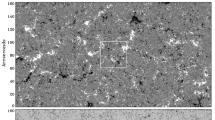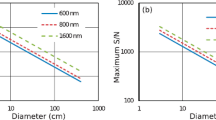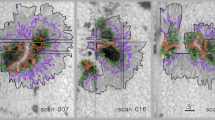Abstract
We study 7530 sunspot umbrae and pores measured by the Hinode Spectropolarimeter (SP) between November 2006 and November 2012. We primarily seek confirmation of the long term secular decrease in the mean magnetic field strength of sunspot umbrae found by Penn and Livingston (IAU Symp. 273, 126, 2011) between 1998 and 2011. The excellent SP photometric properties and full vector magnetic field determinations from full-Stokes Milne–Eddington inversions are used to address the interrelated properties of the magnetic field strength and brightness temperature for all umbral cores. We find non-linear relationships between magnetic field strength and umbral temperature (and continuum contrast), as well as between umbral radius and magnetic field strength. Using disambiguated vector data, we find that the azimuths measured in the umbral cores reflect an organization weakly influenced by Joy’s law. The large selection of umbrae displays a log-normal size spectrum similar to earlier solar cycles. Influenced by the amplitude of the solar cycle and the non-linear relationship between umbral size and core magnetic field strength, the distribution of core magnetic field strengths, fit most effectively with a skew-normal distribution, shows a weak solar cycle dependence. Yet, the mean magnetic field strength does not show a significant long term trend.










Similar content being viewed by others
References
Azzalini, A.: 1985, A class of distributions which includes the normal ones. Scand. J. Stat., 171 – 178.
Baumann, I., Solanki, S.K.: 2005, On the size distribution of sunspot groups in the Greenwich sunspot record 1874 – 1976. Astron. Astrophys. 443, 1061 – 1066. doi: 10.1051/0004-6361:20053415 .
Berdyugina, S.V.: 2011, Polarimetry of cool atmospheres: from the Sun to exoplanets. In: Kuhn, J.R., Harrington, D.M., Lin, H., Berdyugina, S.V., Trujillo-Bueno, J., Keil, S.L., Rimmele, T. (eds.) Solar Polarization 6 CS-437, Astron. Soc. Pac., San Francisco, 219 – 235.
Bogdan, T.J., Gilman, P.A., Lerche, I., Howard, R.: 1988, Distribution of sunspot umbral areas – 1917 – 1982. Astrophys. J. 327, 451 – 456. doi: 10.1086/166206 .
Borrero, J.M., Rempel, M., Solanki, S.K.: 2010, Spectropolarimetric analysis of 3D MHD sunspot simulations. Astron. Nachr. 331, 567 – 569. doi: 10.1002/asna.201011373 .
Centeno, R., Lites, B., de Wijn, A.G., Elmore, D.: 2009, Hinode’s SP and G-band co-alignment. In: Lites, B., Cheung, M., Magara, T., Mariska, J., Reeves, K. (eds.) The Second Hinode Science Meeting: Beyond Discovery – Toward Understanding CS-415, Astron. Soc. Pac., San Francisco, 323 – 326.
Eddy, J.A.: 1976, The Maunder minimum. Science 192, 1189 – 1202. doi: 10.1126/science.192.4245.1189 .
Fan, Y., Fisher, G.H., Deluca, E.E.: 1993, The origin of morphological asymmetries in bipolar active regions. Astrophys. J. 405, 390 – 401. doi: 10.1086/172370 .
Ichimoto, K., Lites, B., Elmore, D., Suematsu, Y., Tsuneta, S., Katsukawa, Y., Shimizu, T., Shine, R., Tarbell, T., Title, A., Kiyohara, J., Shinoda, K., Card, G., Lecinski, A., Streander, K., Nakagiri, M., Miyashita, M., Noguchi, M., Hoffmann, C., Cruz, T.: 2008, Polarization calibration of the Solar Optical Telescope onboard Hinode. Solar Phys. 249, 233 – 261. doi: 10.1007/s11207-008-9169-9 .
Jaeggli, S.A., Lin, H., Uitenbroek, H.: 2012, On molecular hydrogen formation and the magnetohydrostatic equilibrium of sunspots. Astrophys. J. 745, 133. doi: 10.1088/0004-637X/745/2/133 .
Karachik, N.V., Pevtsov, A.A., Abramenko, V.I.: 2010, Formation of coronal holes on the ashes of active regions. Astrophys. J. 714, 1672 – 1678. doi: 10.1088/0004-637X/714/2/1672 .
King, R.B.: 1934, A preliminary survey of the Zeeman effect in the sun-spot spectrum. Astrophys. J. 80, 136 – 153. doi: 10.1086/143589 .
Kopp, G., Rabin, D.: 1992, A relation between magnetic field strength and temperature in sunspots. Solar Phys. 141, 253 – 265. doi: 10.1007/BF00155178 .
Kosugi, T., Matsuzaki, K., Sakao, T., Shimizu, T., Sone, Y., Tachikawa, S., Hashimoto, T., Minesugi, K., Ohnishi, A., Yamada, T., Tsuneta, S., Hara, H., Ichimoto, K., Suematsu, Y., Shimojo, M., Watanabe, T., Shimada, S., Davis, J.M., Hill, L.D., Owens, J.K., Title, A.M., Culhane, J.L., Harra, L.K., Doschek, G.A., Golub, L.: 2007, The Hinode (Solar-B) mission: an overview. Solar Phys. 243, 3 – 17. doi: 10.1007/s11207-007-9014-6 .
Leonard, T., Choudhary, D.P.: 2008, Intensity and magnetic field distribution of sunspots. Solar Phys. 252, 33 – 41. doi: 10.1007/s11207-008-9256-y .
Lites, B.W.: 2009, SOT/SP LEVEL2 data description, http://sot.lmsal.com/data/sot/level2d/sotsp_level2_description.html . Online; Accessed 20 November 2012.
Lites, B.W., Ichimoto, K.: 2013, The SP_PREP data preparation package for the Hinode spectro-polarimeter. Solar Phys. 283, 601 – 629. doi: 10.1007/s11207-012-0205-4 .
Lites, B.W., Low, B.C., Martinez Pillet, V., Seagraves, P., Skumanich, A., Frank, Z.A., Shine, R.A., Tsuneta, S.: 1995, The possible ascent of a closed magnetic system through the photosphere. Astrophys. J. 446, 877 – 894. doi: 10.1086/175845 .
Lites, B.W., Akin, D.L., Card, G., Cruz, T., Duncan, D.W., Edwards, C.G., Elmore, D.F., Hoffmann, C., Katsukawa, Y., Katz, N., Kubo, M., Ichimoto, K., Shimizu, T., Shine, R.A., Streander, K.V., Suematsu, A., Tarbell, T.D., Title, A.M., Tsuneta, S.: 2013, The Hinode spectro-polarimeter. Solar Phys. 283, 579 – 599. doi: 10.1007/s11207-012-0206-3 .
Livingston, W., Penn, M.J., Svalgaard, L.: 2012, Decreasing sunspot magnetic fields explain unique 10.7 cm radio flux. Astrophys. J. Lett. 757, L8. doi: 10.1088/2041-8205/757/1/L8 .
Livingston, W., Harvey, J.W., Malanushenko, O.V., Webster, L.: 2006, Sunspots with the strongest magnetic fields. Solar Phys. 239, 41 – 68. doi: 10.1007/s11207-006-0265-4 .
Maltby, P.: 1977, On the difference in darkness between sunspots. Solar Phys. 55, 335 – 346. doi: 10.1007/BF00152577 .
Maltby, P., Avrett, E.H., Carlsson, M., Kjeldseth-Moe, O., Kurucz, R.L., Loeser, R.: 1986, A new sunspot umbral model and its variation with the solar cycle. Astrophys. J. 306, 284 – 303. doi: 10.1086/164342 .
Markwardt, C.B.: 2009, Non-linear least-squares fitting in IDL with MPFIT. In: Bohlender, D.A., Durand, D., Dowler, P. (eds.) Astronomical Data Analysis Software and Systems XVIII CS-411, Astron. Soc. Pac., San Francisco, 251 – 254.
Martinez Pillet, V., Vazquez, M.: 1993, The continuum intensity-magnetic field relation in sunspot umbrae. Astron. Astrophys. 270, 494 – 508.
Mathew, S.K., Solanki, S.K., Lagg, A., Collados, M., Borrero, J.M., Berdyugina, S.: 2004, Thermal-magnetic relation in a sunspot and a map of its Wilson depression. Astron. Astrophys. 422, 693 – 701. doi: 10.1051/0004-6361:20040136 .
Mathew, S.K., Martínez Pillet, V., Solanki, S.K., Krivova, N.A.: 2007, Properties of sunspots in cycle 23. I. Dependence of brightness on sunspot size and cycle phase. Astron. Astrophys. 465, 291 – 304. doi: 10.1051/0004-6361:20066356 .
Nagovitsyn, Y.A., Pevtsov, A.A., Livingston, W.C.: 2012, On a possible explanation of the long-term decrease in sunspot field strength. Astrophys. J. Lett. 758, L20. doi: 10.1088/2041-8205/758/1/L20 .
Norton, A.A., Gilman, P.A.: 2004, Magnetic field-minimum intensity correlation in sunspots: a tool for solar dynamo diagnostics. Astrophys. J. 603, 348 – 354. doi: 10.1086/381362 .
Penn, M.J., Livingston, W.: 2006, Temporal changes in sunspot umbral magnetic fields and temperatures. Astrophys. J. Lett. 649, L45 – L48. doi: 10.1086/508345 .
Penn, M.J., Livingston, W.: 2011, Long-term evolution of sunspot magnetic fields. In: Prasad Choudhary, D., Strassmeier, K.G. (eds.) IAU Symposium 273, 126 – 133. doi: 10.1017/S1743921311015122 .
Penn, M.J., MacDonald, R.K.D.: 2007, Solar cycle changes in sunspot umbral intensity. Astrophys. J. Lett. 662, L123 – L126. doi: 10.1086/519558 .
Penn, M.J., Walton, S., Chapman, G., Ceja, J., Plick, W.: 2003, Temperature dependence of molecular line strengths and Fe i 1565 nm Zeeman splitting in a sunspot. Solar Phys. 213, 55 – 67.
Pevtsov, A.A., Nagovitsyn, Y.A., Tlatov, A.G., Rybak, A.L.: 2011, Long-term trends in sunspot magnetic fields. Astrophys. J. Lett. 742, L36. doi: 10.1088/2041-8205/742/2/L36 .
Pierce, K.: 2000, In: Cox, A.N. (ed.) Allen’s Astrophysical Quantities.
Rempel, M., Schüssler, M., Cameron, R.H., Knölker, M.: 2009, Penumbral structure and outflows in simulated sunspots. Science 325, 171 – 174. doi: 10.1126/science.1173798 .
Rezaei, R., Beck, C., Schmidt, W.: 2012, Variation in sunspot properties between 1999 and 2011 as observed with the Tenerife Infrared Polarimeter. Astron. Astrophys. 541, A60. doi: 10.1051/0004-6361/201118635 .
Schad, T.A., Penn, M.J.: 2010, Structural invariance of sunspot umbrae over the solar cycle: 1993 – 2004. Solar Phys. 262, 19 – 33. doi: 10.1007/s11207-009-9493-8 .
SIDC-team: 2012, The International Sunspot Number. Monthly Report on the International Sunspot Number.
Solanki, S.K., Walther, U., Livingston, W.: 1993, Infrared lines as probes of solar magnetic features. VI. The thermal-magnetic relation and Wilson depression of a simple sunspot. Astron. Astrophys. 277, 639 – 647.
Stix, M.: 2004, The Sun: An Introduction.
Tsuneta, S., Ichimoto, K., Katsukawa, Y., Nagata, S., Otsubo, M., Shimizu, T., Suematsu, Y., Nakagiri, M., Noguchi, M., Tarbell, T., Title, A., Shine, R., Rosenberg, W., Hoffmann, C., Jurcevich, B., Kushner, G., Levay, M., Lites, B., Elmore, D., Matsushita, T., Kawaguchi, N., Saito, H., Mikami, I., Hill, L.D., Owens, J.K.: 2008, The Solar Optical Telescope for the Hinode mission: an overview. Solar Phys. 249, 167 – 196. doi: 10.1007/s11207-008-9174-z .
Watson, F.T., Fletcher, L., Marshall, S.: 2011, Evolution of sunspot properties during solar cycle 23. Astron. Astrophys. 533, A14. doi: 10.1051/0004-6361/201116655 .
Wenzel, R., Berdyugina, S.V., Fluri, D.M., Arnaud, J., Sainz-Dalda, A.: 2010, Sunspot umbra atmosphere from full Stokes inversion. In: Cranmer, S.R., Hoeksema, J.T., Kohl, J.L. (eds.) SOHO-23: Understanding a Peculiar Solar Minimum, Astronomical Society of the Pacific Conference Series 428, 117 – 121.
Acknowledgements
TAS is a research associate at the NSO. The NSO is operated by the Association of Universities for Research in Astronomy, Inc. (AURA), under cooperative agreement with the National Science Foundation. Thanks are extended to Sanjay Gosain and Fraser Watson for helpful comments, as well as to the referee for a constructive input. Hinode is a Japanese mission developed and launched by ISAS/JAXA, collaborating with NAOJ as a domestic partner, NASA and STFC (UK) as international partners. Scientific operation of the Hinode mission is conducted by the Hinode science team organized at ISAS/JAXA. This team mainly consists of scientists from institutes in the partner countries. Support for the post-launch operation is provided by JAXA and NAOJ (Japan), STFC (UK), NASA, ESA, and NSC (Norway).
Author information
Authors and Affiliations
Corresponding author
Rights and permissions
About this article
Cite this article
Schad, T.A. On the Collective Magnetic Field Strength and Vector Structure of Dark Umbral Cores Measured by the Hinode Spectropolarimeter. Sol Phys 289, 1477–1498 (2014). https://doi.org/10.1007/s11207-013-0412-7
Received:
Accepted:
Published:
Issue Date:
DOI: https://doi.org/10.1007/s11207-013-0412-7




